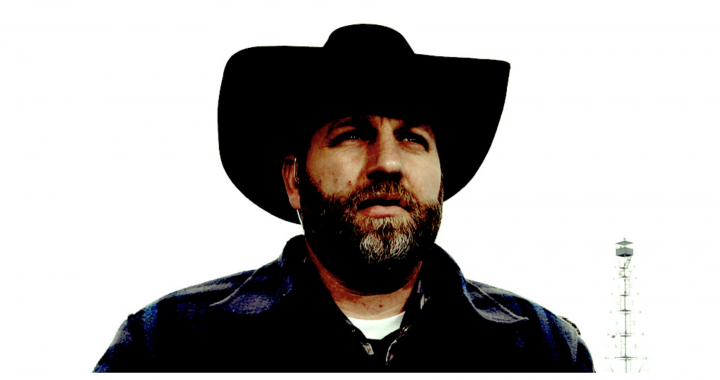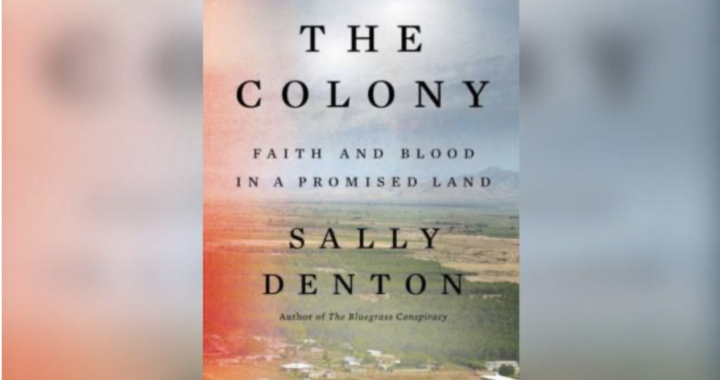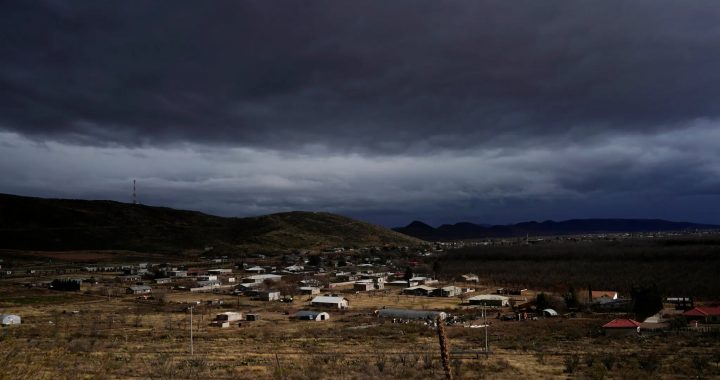On January 2nd, 2016, dozens of regional militias answered a clarion call to “All Good Men and Women” to go fight “the government tyranny” of two eastern Oregon ranchers. “Come and be part of assisting the people in claiming & using their lands and resources,” Bunkerville, Nevada rancher Cliven Bundy wrote on his family blog. And come they did to the Malheur National Wildlife Refuge near the town of Burns: white supremacists, anti-Muslims, anti-gays, anti-Semites—a ragtag of factions and offshoots of the anti-Obama radical “patriots” from throughout the land. They openly carried weapons, Gadsden flags bearing the coiled rattlesnake and “Don’t Tread on Me” slogan, and crisp copies of the US Constitution with the Second Amendment highlighted.
+
BOOKS DISCUSSED IN THIS ESSAY
Shadowlands: Fear and Freedom at the Oregon Standoff, Anthony McCann (Bloomsbury; July 2, 2019) · This Land: How Cowboys, Capitalism, and Corruption are Ruining the American West, Christopher Ketcham (Viking; July 16, 2019) · Chosen Country: A Rebellion in the West, James Pogue (Henry Holt, 2018)
+
They came as groups and individuals. The Oath Keepers. The West Mountain Rangers. Operation Mutual Defense. The Indiana Rangers. The Massachusetts Fighting Wolves Militia Corp. The Radical American Patriots of Georgia. The Mountain Minutemen. The Modern American Revolution. OpenCarry.org.
All idolized Bundy, the colorful Mormon patriarch and Las Vegas native who had staged a show of force against the US Bureau of Land Management two years earlier at his desert ranch. For 25 years, he had illegally run his cattle on federal land and piled up $1 million in unpaid grazing fees. Dressed in Army fatigues and full tactical gear, openly armed with holstered handguns and assault rifles, the militant muscle among Bundy’s followers would almost certainly have triggered a bloodbath had the federal agents not retreated from the confrontation.
What the protestors brought to this “arena for angry minds,” as historian Richard Hofstadter had famously described the old and recurrent condition of anti-government paranoia infecting American politics 50 years earlier, was fear that the federal government was a tyrannical force determined to destroy the Constitution.
The occupation at Malheur was organized by two of Cliven’s dozen sons who urged ranchers to rise up and renounce US ownership of public land and return it to “We the People.” The two brothers, Ammon and Ryan, led the armed “Ammonites” that seized the Oregon refuge to protest the prison sentences a federal court had imposed on the two Oregon ranchers convicted of arson after setting a brush fire on their ranch that crossed onto the 188,000-acre Malheur sanctuary. The ranchers hadn’t asked for help, and by many accounts didn’t want it. But the Bundy militants seized the public relations opportunity for their insurrection.
After a three-week siege of the property, law enforcement ambushed and arrested Ammon and Ryan along with six others, and killed one of the Bundys’ cowboy militiamen: Robert LaVoy Finicum, an aspiring martyr for the cause and vocal devotee of Timothy McVeigh, who was executed in 2001 for bombing a federal building in Oklahoma City, was fatally shot in a confrontation with the FBI.
Even after the arrests and Finicum’s death, a group of AR-15-packing militia members remained in the compound. The four holdouts were a motley crew of Bundy loyalists and “lost boys”—as the young men are called who have been banished from polygamous Mormon fundamentalist communities to reduce competition for wives. Bedraggled, camouflage-clad, and with nothing much going on in their lives, they were the lowest common denominator in the Bundy pecking order.
Although Ammon, from his Oregon jail cell, called for them to “stand down,” a heavily armed civilian posse continued to roll into the area at the urging of Ammon’s father. But by February 11th, everyone who participated in the 40-day occupation had either surrendered or left the compound, and more than two dozen had been charged with federal offenses, including Cliven. It turns out “We the People” was code for a handful of white ranchers who wanted the government to return to them millions of acres of federal land owned by all Americans.
The Malheur saga is but the latest iteration of the kind of anti-regulatory stance that led to Reagan’s 1980 presidential campaign—and to his famous battle cry for a “Sagebrush Rebellion.” Proclaiming himself a “rebel,” Reagan supported claims that federal ownership of land within the Western states’ boundaries was unconstitutional. He rode that wave all the way to the White House, carrying every state west of the Mississippi River.
Thirty-five years later, the same anti-government hysteria that led to the Reagan Revolution is back in full force, nurtured by an incendiary 2016 presidential campaign, fanned by volatile identity politics and a ramped up armed sedition trend spawned by the election of Barack Obama. The current public spectacle of guns and gun violence—and the fear and obsession that the government is going to “take away guns”—is unprecedented though America has a long history of gun rights activism.
This conflict is not going away, and the American West is the battleground where history and rebellion meet. The resentment and disaffection is deep and historic. It is strengthening, not diminishing. Nowhere else in the country is such restlessness felt as in the West, where the messianic Ammonites were led by God to make their stand. “On the plains of heaven,” as Milton wrote in Paradise Lost.
Into this cauldron of conspiracy and sedition arrived California poet Anthony McCann. Shadowlands: A Western Tale of America in Crisis. Fear and Freedom at the Oregon Standoff is McCann’s first book of narrative nonfiction. Elegantly rendered and deeply researched, Shadowlands brings seriousness to characters that are easily caricatured, and substance to a subject easily marginalized. The Citizens for Constitutional Freedom (CCF), as Ammon Bundy has named his divinely inspired anti-federal land movement, is relevant, revolutionary, and roused.
McCann portrays an epic story of the American West and its romantic and turbulent 150 years of history. He captures the drama that setting has to offer—from the Mormons and Native Americans, to the ranchers and miners and sheepherders, and the politicians that incite these conflicts. Outraged by what he calls “cowboy Ayn Randianism,” McCann explores the “democratic and dystopian” elements of this singularly homegrown extremist movement.
As Ammon and his acolytes saw it, the time was now for a Mormon leader to guide the second coming of Christ and install the political Kingdom of God in Washington, DC.In his first pages, McCann identifies the Church of Jesus Christ of Latter-day Saints as a leading influence behind the violent separatist movement in the West. The church had originally designated the land for the Bundy ranch in the 1800s for Cliven’s forbears who were devout members and obedient agents. McCann recounts the famous story of church founder Joseph Smith—the fortunetelling grave robber from Palmyra, New York who dabbled in the occult before receiving an order from an angel named Moroni directing him to write the Book of Mormon in 1829. That 275,000-word Game of Thrones-like blockbuster of heroes and villains was a runaway bestseller, catapulting Smith to fame and cementing his status as leader of a religion where “all worthy males” could become priests. Ruling his flock through divine revelation, Smith’s heaven allowed these worthy men to become kings of their own worlds.
America was only half-a-century old when hundreds of thousands of Europeans began immigrating as followers of Smith’s evangelical socialism and revolutionary utopia. But from the beginning, Smith had a keen eye toward martyrdom, which became a self-fulfilling prophecy when he was murdered in 1844 by an anti-Mormon mob in Illinois while a candidate for the US presidency. Running as commander in chief of an “Army of God,” Smith advocated the overthrow of the federal government in favor of a Mormon-ruled “theodemocracy,” and viewed capturing the presidency as part of the mission of the church. He predicted the emergence of “the one Mighty and Strong”—a leader who would “set in order the house of God”—and became the first of many prominent Mormon men to claim the mantle.
Following Smith’s death, Brigham Young ascended to lead the church and rule the followers, now called “Saints.” A divine revelation directed him to move them out of America where they were being tirelessly persecuted. Searching for Zion, he ended up in the remote, sparsely populated Rocky Mountain region then belonging to Mexico—now the state of Utah—and began colony-building in the Far West. “Retreating from Christians,” as Young said at the time, his band of Saints were gripped by paranoia. They were viewed with suspicion for their devotion to material wealth, feared for Smith’s (and Young’s) sophisticated armed militia, distrusted for their block voting and self-identification as the “Chosen People,” despised for their practice of polygamy, and ridiculed for their religious fanaticism. As a result, the Saints adopted a siege mentality during the exodus to their new homeland on the shores of the Great Salt Lake.
“America loves to make fun of its Mormons,” writes McCann, who contrasts that ridicule with the earnest and charismatic leader of the Ammonites. “Ammon is a different figure of masculinity—a right-wing version of the sensitive man. His public face is a real-time concern that he has consistently poured forth in every interview, every press conference, every appearance on the witness stand, delivering his payload of sincerity each and every time.” But while McCann is right that Ammon’s “openness of expression” is “uncommon among men of the American right wing”—especially at odds with such Patriot faces as ubiquitous Bundyites Roger Stone and Larry Klayman—there is a sense of theater in Ammon’s affect. As David Ward, sheriff of Oregon’s Harney County put it, his supporters were “setting up Ammon as a prophet.” As Ammon stepped forth as the leader of the family, the image of the Bundys as deadbeat ranchers and what writer Tim Egan called “thugs on the range” receded.
Still, staged or not, Ammon’s followers consider him a genius, if not a prophet. The Mormon sect’s essential doctrine stipulated as a condition of Christ’s return to earth that the American Indians would join the faith. That Ammon was named for a Ute chief was seen as a sign by his disciples that he was “the One Mighty and Strong” ushering in the “latter days” as Smith had foretold. To foster that belief, Ammon began citing what was known in Mormon circles as the “White Horse Prophecy”—a belief that grew out of Smith’s national political ambitions and was ingrained in Mormon culture, passed down through generations of church leaders.
Mormons were taught that America is the Promised Land and that a day would come when the US Constitution would “hang like a thread as fine as a silk fiber” and the Mormon priesthood would save it. As Ammon and his acolytes saw it, the time was now for a Mormon leader to guide the second coming of Christ and install the political Kingdom of God in Washington, DC. “General Ammon” had answered the call.
The controversial apocalyptic myth is not an official church doctrine, and even though over the years it has come up in the national dialogue with the candidacies of Mormons Mitt Romney and Orrin Hatch, the modern Mormon Church, struggling to shed its extremist history, has officially disavowed it. The more Ammon alluded to the White Horse Prophecy, the more the church distanced itself from his cause, issuing a strong statement against the Ammonites: “While the disagreement occurring in Oregon about the use of federal lands is not a Church matter, Church leaders strongly condemn the armed seizure of the facility and are deeply troubled by the reports that those who have seized the facility suggest that they are doing so based on scriptural principles. This armed occupation can in no way be justified on a scriptural basis.”
McCann’s Shadowlands is but one of more than a dozen recent books about the Bundy Revolution—most of which have been written either by “revolutionary” insiders or non-western journalists attracted to the drama of the story playing out in the Far West. “The occupation, as well as the trials and protest events that followed it, were documented to such a degree that . . . easily surpass the hours taken up by the events themselves,” as McCann explains the massive trove of online videos, law enforcement reports, trial testimony, news stories, dispatches from “citizen journalists,” films, podcasts, and social media.
McCann is one of three male writers who have recently chosen the Malheur Occupation as the subject for their first nonfiction books. Curiously, all three are writing in the first person, as if the West is the last American frontier best explored through immersion and personal experience. Journalist Christopher Ketcham’s This Land: How Cowboys, Capitalism, and Corruption are Ruining the American West (Viking, July 2019) is a deep investigative dive into the fate of public lands. James Pogue’s Chosen Country: A Rebellion in the West (Henry Holt, May 2018) is a rollicking reporter’s tale from inside Ammon Bundy’s cult-like revolution.
All three books have alluring covers, with varying shades of blue evoking the western sky. All have titles and subtitles with buzzwords conjuring the romance of cowboys and rebellion, patriots and ranchers. The struggle over federal public land policy in the rural West provides rich material for talented writers, and these three all rise to meet the subject. Yet each also brings a gee-whizzery aspect to their reporting as if in uncharted territory.
Ketcham has elsewhere described his hefty polemic as a “product of love and anger.” At the heart of the public lands battle, as Ketcham sees it, is the corruption of the federal land management agencies that have been captured by the private industries—livestock, energy, and timber—they are supposed to be regulating on the public’s behalf. Unabashedly provocative, Ketcham admits to writing This Land “in a narrative style that hopefully will outrage my fellow citizens.”
From Pogue’s Gonzo drinking and sexual encounters, to Ketcham’s unforgettable description of a masturbating mustang, to McCann’s juxtaposing encounter with both a hostile Harley rider and a “fantastic” desert tortoise. Each seem to be channeling their personal literary forbears. If Pogue is imitative of Hunter Thompson, and Ketcham of Edward Abbey, then McCann is a cross between Carlos Castaneda and Henry David Thoreau. In the end, we know almost as much about Pogue, Ketcham, and McCann as we do about the Bundys.
The Citizens for Constitutional Freedom (CCF), as Ammon Bundy has named his divinely inspired anti-federal land movement, is relevant, revolutionary, and roused.Each has captured aspects of this sweeping story about the many concentric circles of American life that can be found in the West—a place where the new and old worlds converge and collide. It is a 21st-century crossroads where every pressing issue of the day is playing out in unvarnished view. From crushing income disparity to populist presidential politics, the depletion of natural resources to the modernizing of the military industrial complex, water wars to drone armies and nuclear bombs, shadowy LLCs and Chinese money pouring into the economy and politics to billion-dollar public-private boondoggles, gambling titans to cowboy militias, the rise of corporate media to the oligarch-run newspapers.
The story of the West is the story of America—a laboratory where America’s grand 19th-century design of Manifest Destiny morphed into the 21st century’s autonomous western economy and the rise of what has become the Corporate West. McCann, in thrall to Patricia Limerick, historian with the Center of the American West at the University of Colorado, cites her credo to “never let yourself settle into one viewpoint” as a radical interpretation. McCann embraces Limerick’s assessment that conflict and disagreement are a great thing. “It saves us from what she called, her face recoiling at the thought, as if she’d taken a slug of milk gone sour, the ‘cloying and very dreadful experience of everyone being delighted with each other.’ I laughed, the whole room laughed,” McCann writes. The question of whether conservation can coexist with democracy is a dynamic experiment, according to Limerick, and we don’t yet know the outcome.
When it was all over, 27 people involved in the Malheur Occupation were charged under federal law. Ammon Bundy and six other defendants were found not guilty at a jury trial. Most others received lenient sentences.
In July 2018, President Trump pardoned the Oregon cattle ranchers, Dwight and Steven Hammond, who had been convicted of setting fires on federal land, calling their prosecutions “overzealous” and their five-year sentences “unjust.” Forrest Lucas, a multimillionaire Indiana tycoon and friend of Vice President Mike Pence, had brought their case to the attention of the White House. Lucas then sent his private jet to pick up the Hammonds from prison and transport them back to their home in eastern Oregon—a quintessentially symbolic gesture of the Trump administration’s hold on America’s disaffected fringe.


